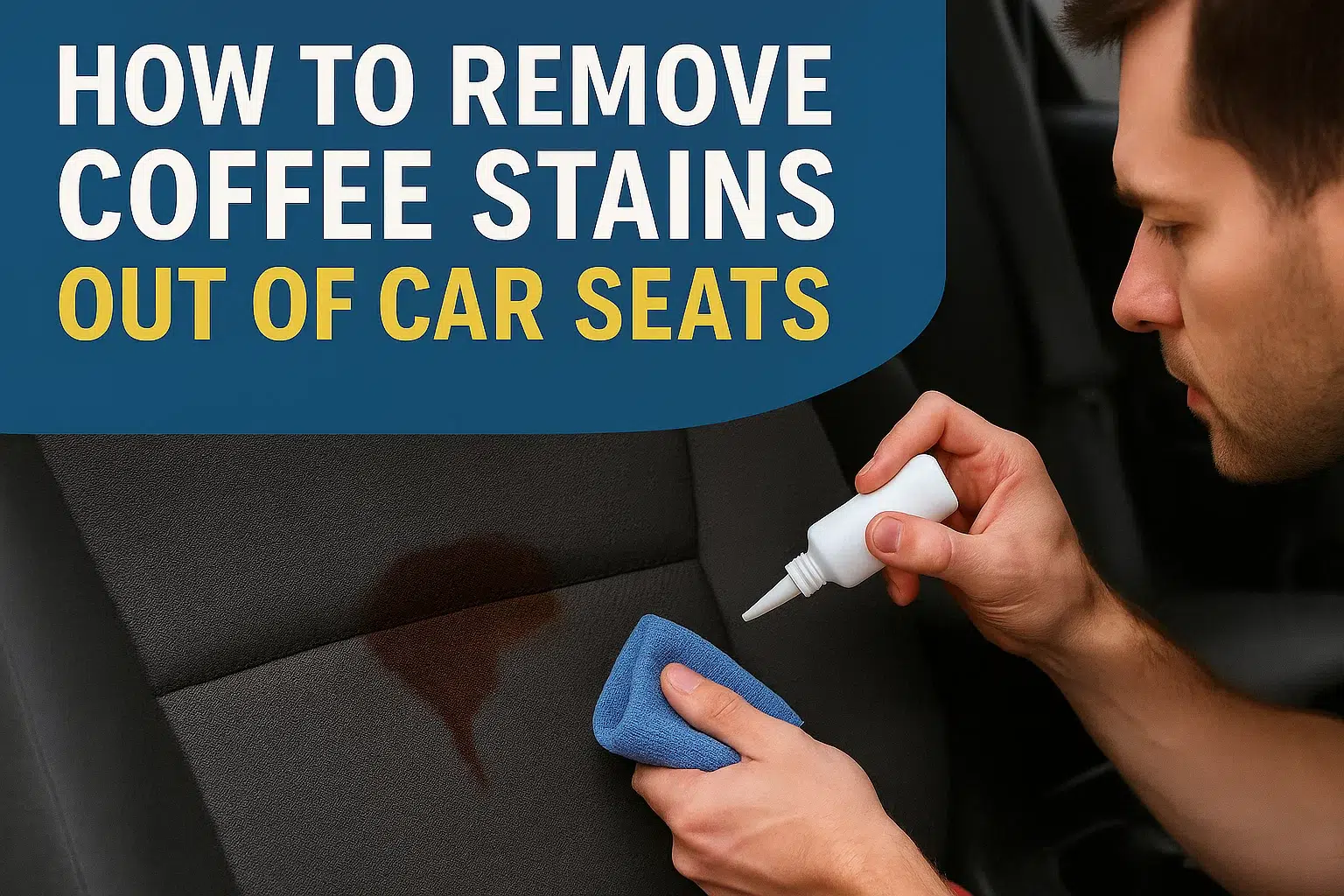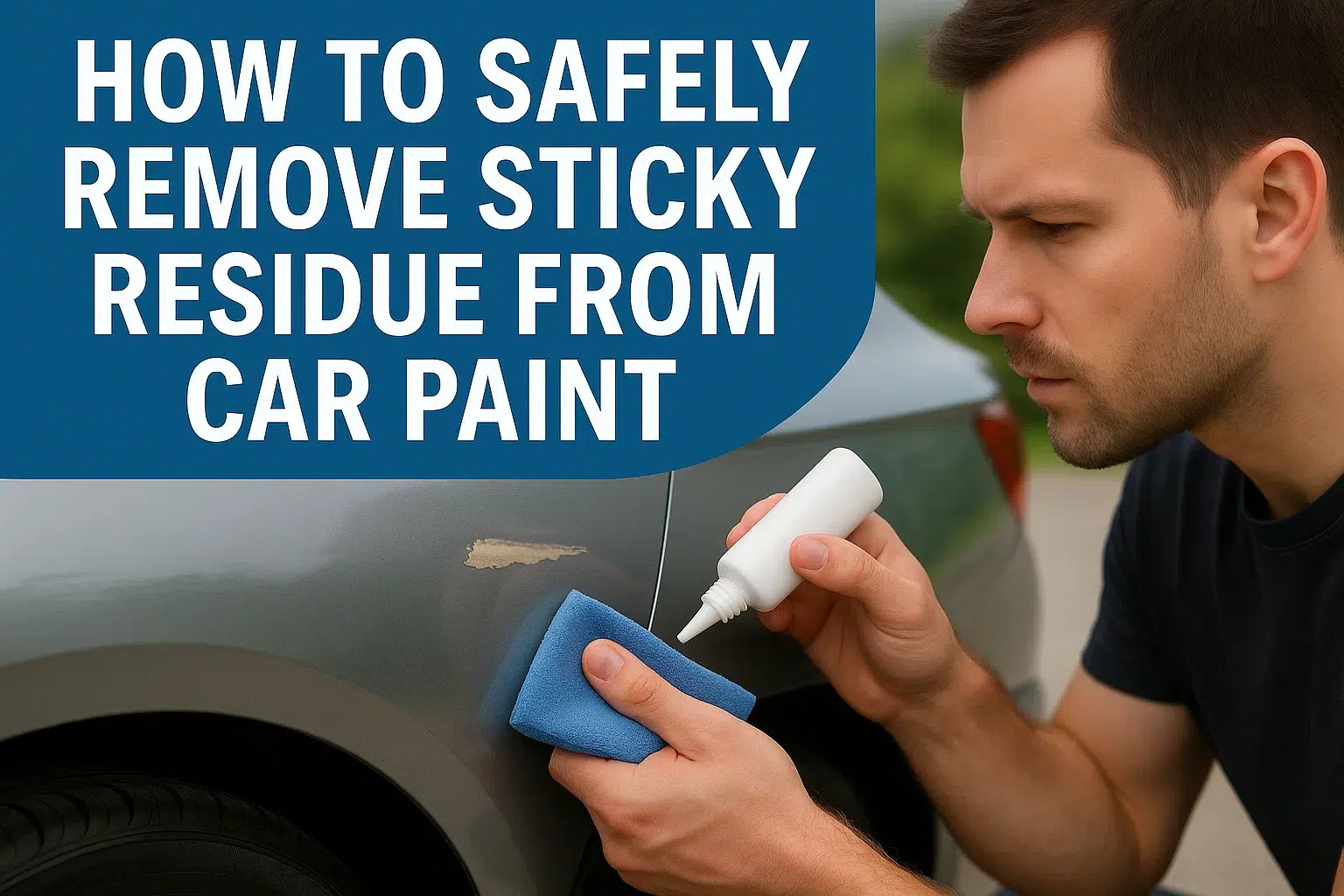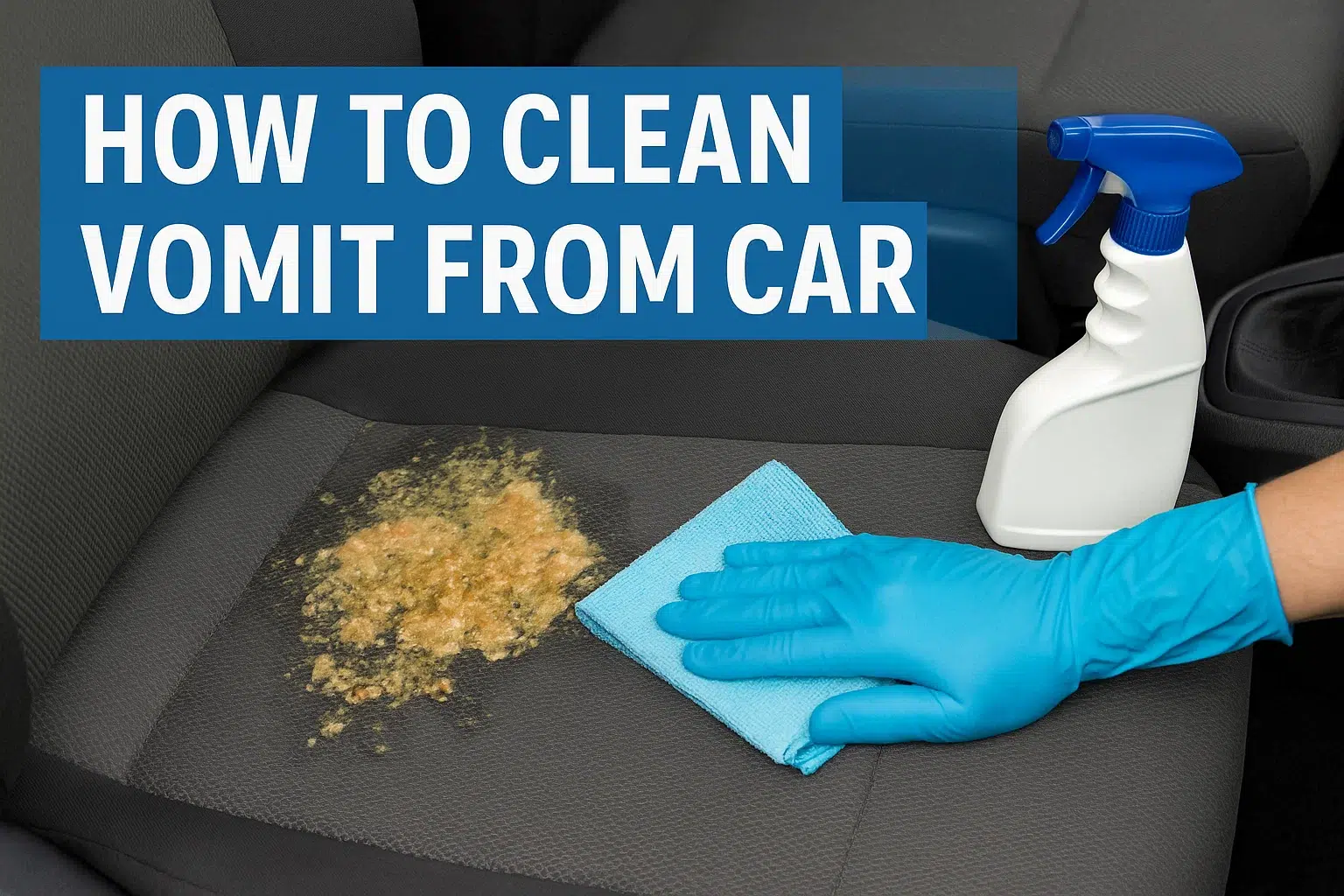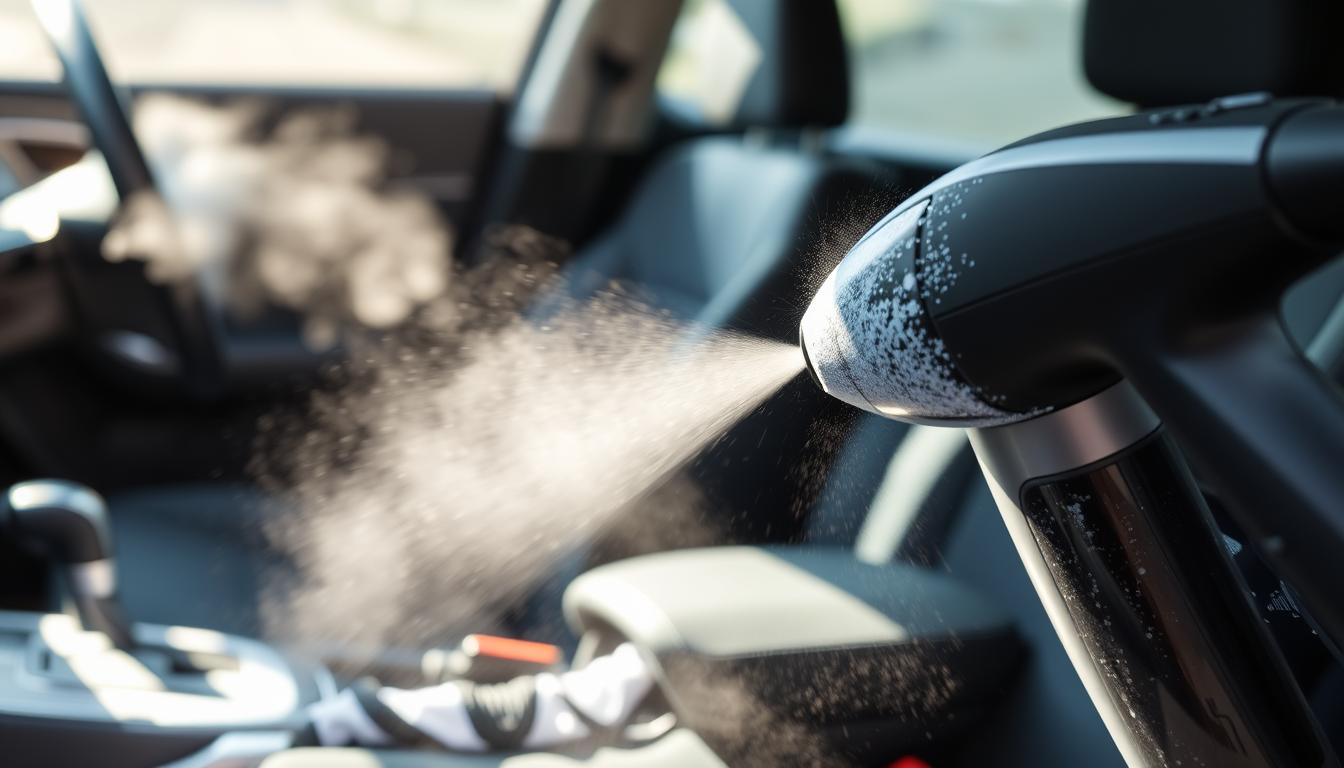To remove coffee stains from car seats, it is effective to blot the stain immediately and wash the area with a mixture of dish soap, vinegar, and warm water. To deal with stubborn stains that have set in, gently scrub the area with a paste made from vinegar and baking soda until the paste dries, then blot off the residue. If strong odors still persist after cleaning, activated charcoal or baking soda placed overnight can help eliminate them.
Coffee spills in car interiors can be a real nuisance. Whether it’s during a hectic morning drive or due to an unintentional jostle, coffee is one of the liquids that can cause interior damage if not handled correctly. Largely, it results in staining, lingering smells, further degrading the surfaces such as in leather seats and even enhances mildew growth. The good part? If treated swiftly and correctly, you do not have to worry about reupholstery or detailing.
In this guide, we discuss removing coffee stains from car seats regardless of how deep the damage runs: whether they are spots you’ve attempted to conceal or recollections that have faded over time, we will ensure you know how to treat stained fabric, leather, and synthetic seats odorlessly while ensuring the stain does not return. Additionally, and beyond the scope of this guide including maintenance that helps retain your car’s value and dealing with coffee stains inside cars.
Why Coffee Stains Are So Tough to Remove
The composition of coffee includes tannins and oils which can bond easily to porous materials such as cloth upholstery. This implies that the longer a coffee spill in a car is left unattended, the more deeply it sets into the fibers. If not treated quickly, coffee stains can lead to:
Car seats may get
- Permanent discoloration
- Persistent bad smell
- Growth of bacteria and mold
- Deterioration in quality and structure of seat fabric
Even if you have only spilled coffee on your car seat once, adding heat and moisture can make the ‘spilled coffee on a car seat’ aroma overpowering if not dealt with properly.
How to Remove Fresh Coffee Stains – Step by Step
Let’s explore fresh coffee odor and how achieving early results brings out the signature flavors and aroma.
Materials You Will Require:
- Paper or microfiber towels
- Mild dishwashing liquid
- Vinegar (White in color)
- Warm water
- Cleaning spray container
- Soft-bristled brushes or old toothbrushes are recommended.
- Vacuum
- (Optional) Car seat baking soda coffee stain cleaner mix.
Steps:
To remove fresh stains, these steps need to be taken immediately.
- Blot Immediately
Dab the affected area with a towel and soak up any liquid using gentle pressure. Scrubbing will exacerbate the damage done to your fabric or material by pushing stains deeper inside.
- Apply Removing Solution
In a spray bottle, add one tablespoon of dish soap, one tablespoon white vinegar, and two cups of warm water. Now shake well so the solution can be applied generously on the stained surface.
- Gently Scrub
Using soft bristled brushes, scrub the fabric in circular motions gently until the stain lightens. Try not to saturate too much liquid if the seat is cushioned.
- Rinse with Water
Remove soap and other residues left by previous steps by blotting with warm damp towels.
- Dry Thoroughly
Repeat vacuuming alternatively pressing dry towels against surfaces until no moisture remains, then allow affected areas to air-dry completely – this prevents mildew growth.
How to Remove Old Coffee Stains from Car Seats
More often than not, light upholstery comes with a price – recurring, persistent stains that necessitate multifaceted scrubbing.
Baking Soda Hack:
Using soda is not only cheap and widely available but also non-toxic and an effective remover of most coffee stains from car seats.
What to Do:
- Carve out some time for this project – it will be tedious depending on how bad the stains are.
- First off, grab your scrub broom. Apply puddles of baking soda over all your beverage based ‘incidents’.
- Fill a spray bottle with equal portions of vinegar and water. Give the stains a spritzing
- After fizzing settles down, a dozen small islands of white powder should remain visible.
- Now comes the fighting phase- using a soft bristle brush to get rid of those unsightly bits gently.
When left overnight, baking soda removes coffee smells from car seats, especially when combined with vinegar.
Removing Coffee Odors After a Spill
The smell of stale coffee and dairy can often stick around even after one tries to clean the second half of a cup spill, especially when cream or milk is added. While the scent of coffee may pass as acceptable, nobody wants to deal with the smell of sour spoiled milk.
Odor Removal Tips:
- Activated Charcoal Bags: Leave some bags under seats for a few days. They will suck out any odors present in that area.
- Vinegar Bowl Overnight: Car odors can be removed by placing open bowls of vinegar overnight as it diffuses strong smells.
- Baking Soda Sprinkle Remover Clay: Letting baking soda sit for the night and vacuuming the next morning aids in removing stubborn pungent odors.
If you notice a musty odor several days after coffee was spilled in your car, be mindful that this could result in the growth of mold inside your car, which is quite serious as it compromises both health and safety while driving.
Difference in Cleaning Leather and Fabric Seats
Fabric Seats:
- Stains from liquids, such as coffee, penetrate deeper as they absorb more.
- Need to be acted on quickly and require thorough cleaning.
- Remedial action can be taken using common household ingredients like baking soda, vinegar, and detergent.
Leather or Faux Leather Seats:
- Less absorbent but more susceptible to acidic liquids that damage the surface.
- Use a pH-neutral leather cleaner.
- Excess water is harmful.
- Condition leather after cleaning to prevent drying or cracking due to losing moisture from too much exposure.
Pro Tip:
Avoid ammonia-based products on leather seats because they will weaken the protective layer making the item vulnerable to fading or flaking off the surface.
Stopping Coffee Spills In The Car
Making sure there are no spills is easier than dealing with a mess made in the car. Here’s some tips to help on how you can avoid coffee spills:
- Use travel mugs that have a sealed lid
- Use cup holder inserts for better grip
- Don’t overfill your cup
- Keep an eye out when driving if there is coffee in the car, especially sudden stops or sharp turns.
Also, upgrading your cup holders or using rubber mats can help catch any spills before they reach your seats and damage them.
When to Call a Professional Car Detailer
If you’ve done your best but the stain (or odor) still remains, it’s best to seek help from a professional.
A Pro Detailer Will:
- Utilize industrial-strength extractors
- Clean deeper with enzyme-based odor removers
- Use protectants on fabrics or upholstery
And if you’re pleased with the outcome, remember to give a tip to car detailer — most especially if they prevented your car from being transformed into an indoor dump!
Coffee and Car Maintenance: Bigger Picture
Though it’s a small problem, spilling coffee can vastly damage the value and tidiness of your car over time. Just like a scratched paint job, a dirty interior that is filled with stains and odors like coffee or mold is extremely unattractive.
If you’re looking to improve your car’s look while keeping overall costings down, make sure to check out some videos on budget car scratch repair.
A vehicle should be maintained by servicing the car on a regular basis for cleaning or even managing spills. This assists in creating a healthier environment which is refreshing, inviting instead of repelling.
Can Spilling Coffee Impact Car Electronics?
In modern cars, especially the newer models, sensors and critical electrical components are placed underneath or around the car seat and during a coffee spill in-car scenario would result in:
- Sticky seat-belt sensors
- Corroded heating elements in the seating surfaces
- Dysfunction of memory settings for the seat position
Having a mechanic inspect your car’s electronics after spilling significant amounts of liquid would certainly be a good idea.
Long-Term Tips for Maintaining Car Seat Hygiene
Your car seats can also sustain damage from food oil, baby formula, or even cleaning up vomit in the car. Apart from coffee, these substances can also be damaging to your car’s seats.
Maintenance Tips:
- To maintain cleanliness, vacuum once a week to remove build-up debris.
- Use machine washable seat covers
- Manage spills as soon as they occur
- Use different scented products but make sure to neutralize odors afterwards
- Do not keep open containers of coffee in the car
When it comes to maintaining a car’s interior hygiene, proactive cleaning is always better than reactive scrubbing.
Eco-Innovative and Electrifying: Make the Change To Electric
If you are contemplating a car change and your car accidents involve coffee spills, then going electric may be a great solution for you.
Take The Big 0 Terramax Electric Car. It has features like automated interior cleaning as well as spill-proof synthetic upholstery. Some models also come with integrated air fresheners alongside microbic protective surfaces that prevent bad odor build-up.
While this won’t stop your coffee from spilling, it sure will make messes less damaging in the long run while being faster to manage post damage clean up.
How Often Should You Deep Clean Your Car Seats?
As a best practice, aim to do some deep cleaning every 2–3 months, check clean for spills, and do spot cleans when needed. If you don’t perform regular cleans, dirt and oil will steadily build up in the fabric which leads to bad odor.
If your car is used often when kids or pets are present, consider doing more cleansing regularly.
When seasonal detailers or mobile detailers come to your house and deal with stains and bad smells, it is advisable to learn about tipping them.
FAQs
How do you get coffee stains out of car seats?
Blot the spill, then clean using a mix of dish soap, vinegar, and warm water; scrub gently and blot dry.
How to get coffee out of car seat?
Use a soft cloth and a cleaning solution of water, vinegar, and mild soap to lift the stain, then rinse and dry.
How to remove coffee stains from car seat?
Apply a cleaning mix of vinegar and soap, scrub gently, and blot to remove the stain without spreading it.
How to get coffee stains out of car seats?
Spray a vinegar-soap solution, scrub lightly with a soft brush, and blot up the residue with a clean towel.
How to get rid of coffee stains on car seat?
Use baking soda and vinegar or a commercial upholstery cleaner to lift old stains and odors effectively.
How to get coffee smell out of car?
Place baking soda or activated charcoal overnight to absorb odors, and ventilate your car thoroughly.
How to remove coffee stain in car seat?
Spray a diluted vinegar solution on the stain, scrub gently, and blot dry; repeat if necessary.
How do I get stains out of my car seats?
Use a gentle upholstery cleaner or a homemade mix of vinegar and baking soda to lift and clean stains.
How to get coffee stain out of car seat?
Clean with a soap and vinegar solution, scrub lightly, then blot until the stain and odor are gone.
How to clean coffee out of car seat?
Blot immediately, apply a cleaning solution, scrub gently, and vacuum or towel dry the area.
Conclusion: Keep Your Car Seats Clean, Stain-Free, and Fresh
With the appropriate tools and techniques right mindset, dealing with odors is a breeze. Likewise for cleaning coffee stains. This is also true to a small “disaster” like coffee spills.
There is always a solution whether it is the smell of old coffee in car seats, fresh sins, or messes made from aged old spills. Most of them are easily available at your pantry. The main components are acting fast, cleaning smartly, and being persistent.
Finally, cars are no longer just considered as mere modes of transport but rather places where families live precious moments together. So ensure cars align with our dwelling hygienic standards: clean, comfy everywhere (including aromatic areas) and odor-free including delightful scents inside – flavored sweetened coffee or whatever cologne products people want but certainly not those ostracizing smells from spills.

I am Tushar Balchandani, founder of Car Info Expert and someone who has been working extensively in the car industry as a car expert for 15 years. My aim is to provide useful truthful and reliable information to the readers based on my real experiences and hands-on experience. From buying tips to maintenance guides, I help readers make confident car-related decisions.




